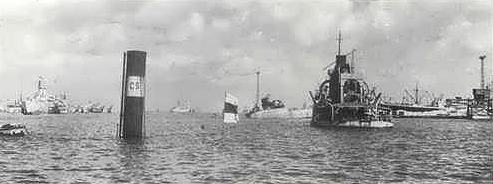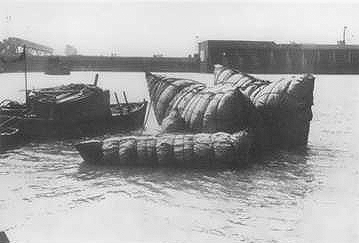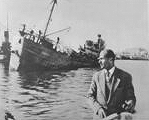It looks like the biggest
engineering problem at Suez will not be the removal of the 50 or so
sunken vessels in the harbour and the canal itself, but the reconditioning
or replacement of the canal equipment, particularly the tugs and dredgers,
and the re-establishment of the fairway.
The tugs and dredgers that were employed on the canal were all specially
made vessels, well suited for the unique conditions under which they
were operated – heavy duty in restricted areas but under fair
weather conditions. Exactly similar ships are not used elsewhere.
It is unlikely that what suitable craft do exist could be spared from
their present tasks to form even temporary replacements at Suez. The
period of adapting or building the craft required, if Colonel Nasser’s
men not only sunk but also destroyed the Canal Company’s vessels,
will be far longer than the three to nine months that have been predicted
for raising the scuttled vessels or removing the other known obstructions.
And with any great lapse of time a very serious problem will have
arisen due to the sand that will have been deposited in the canal.
Continuous dredging was of paramount importance in maintaining an
adequate waterway for the vessels that used the canal – indeed,
it was not unusual for the largest to scrape the soft bottom somewhere
during transit, despite regular work by the Company’s dredgers.
It is unlikely that the condition of the fairway was improved during
the three months in which the Egyptians “owned” and operated
the canal. It is absolutely certain that during the last month of
“armed conflict” negligible action was taken to counter
nature’s efforts to refill the canal with sand. Between 1950
and the end of 1954 it was necessary to excavate 53 million cubic
yards of material to meet the needs of shipping requiring passage.
Six months lapse will generate a pretty problem of balancing the deployment
of improvised dredging equipment against the need to give the first
ships room to pass.
The Egyptian Government may or may not own the canal, but it is quite
certain that they have neither the money nor the equipment to put
it in good order again. They have damaged the canal – even if
not irrevocably – but it is only Western Europe, and in particular
the United Kingdom, which has the capacity and urgent desire to return
it to its former good order.
|
|
OBSTRUCTIONS
The first
full report of the obstructions caused by the Egyptians reached London
last weekend. With twenty wrecks in the harbour at Port Said, the total
number of obstructions – including two blown bridges – was
then put at 50. This figure is based on a full survey within the area
occupied by the Anglo-French forces, that is, as far south as El Cap,
but only on intelligence reports and aerial surveys along the more extensive
southern reaches.
Taking a 25 ft draught ship as a measure, only seven of the obstructions
(including the bridges at El Firdan and Ismailia) south of El Cap are
assessed to be effective, though four more may offer immediate restriction
to the passage of such a ship. Of the others, one is probably ineffective
and 17 certainly make for no difficulty, as they lie clear of the main
channel. In the communique issued by the Admiralty it was observed that
other obstructions, as yet undiscovered, may be present below the surface.
During the boat survey of the Allied-held portion of the canal, the
fairway was wire-swept to a maximum depth of 30 ft and a width of 300
ft without finding anything that was not visible on the surface. (the
channel has a depth of 30 ft or more over a width of about 220 ft, the
full depth of 46 ft in the northern reaches being maintained only for
a width of 118 ft) The
obstruction is not quite as severe as it might have been. Apart from
the vessels belonging to the canal, no craft of any size was available
to the Egyptians. There are however, 12 foreign vessels trapped in the
canal and at least some pressure has been brought (apparently so far
unsuccessfully) on their crews to abandon them. Should they be surrendered
to the Egyptians they too may be scuttled in order to delay clearing
operations further. None of these vessels are British, though two are
tankers on charter to British companies; the Italian Amalfi of 10,387
tons and Panamanian Brigette of 9.243 tons, which would be the largest
vessels forming obstructions if they are eventually sunk.
At Port Tewfik, in the south, the two vessels sunk in the channels are
the salvage vessel Castor and probably a River Class frigate; a third,
a salvage tug, has been scuttled adjacent to the harbour jetty, and
a fourth, a small ship, has been placed across the entrance to Port
Ibrahim, a small fishing harbour outside the original canal concession.
Along the main stretches of the canal the most serious obstructions
are likely to be the suction dredger, Louis Perier and the two bridges
at El Firdan and Ismailia. As the latter was only a pontoon structure
it should not present much difficulty. The bridge at El Firdan, on the
other hand, may prove a more troublesome proposition, for it was a long
span structure completed only 3 or so years ago to give easier navigation
than the old swing bridge built during the war. It will be remembered
that a vessel fouled the piers of the bridge last year, causing a serious
impediment to shipping for a short while.
At Port Said, the wrecks are more extensive, although even here only
seven or eight appear to be in the main channel or in Ismail basin.
By far the largest – and most accurately placed for causing an
obstruction – is the suction dredger Paul Solent. She is reported
to have eight holes in her hull, and, by the weekend, the task of patching
her was well advanced. The other wrecks are comprised of smaller bucket
dredgers, a small floating dock, hoppers and tugs, the largest being
the Hercule, which, though old, is one of the biggest owned by the canal,
with a deadweight of just over 600 tons. She is lying in the fair- way,
but well to one side and facing well into the stream.
Originally, at least three floating cranes – including the 150
ton hammer head – had been sunk across the inner entrance from
the outer basin by the Central Mole. But reports over the weekend showed
that the two smaller cranes – of 15 tons and 80 tons lift –
had already been shifted clear of the channel by the British forces.
If they can quickly be put into working order they will prove invaluable
in clearing the rest of the harbour.
|
CLEARANCE
WORK
Although
political issues and points of international law have still to be
settled on who owns and who is to operate the canal when it is cleared,
it is the British, along her allies, who have the necessary equipment
ready in the quantities required to do the task in a reasonable time.
The United Nations have sent in special observers, with their policing
force, to make an assessment of the damage done to the canal and its
installations, but to get the work done quickly they will have to
accept the offer of salvage resources by the United Kingdom Government.
The organisation assembled at Port Said by the Royal Navy by the middle
of last week (some salvage vehicles were included among the first
Allied forces sent to Port Suez when the present emergency arose)
comprised two ocean salvage vessels, one coastal salvage vessel, one
wreck-dispersal vessel, one boom-defence vessel one 1,200 ton dumb
lifting craft, four salvage pontoons and a tug, together with personnel,
stores and equipment. Foremost among this equipment will have been
air compressors, undersea cutting and welding heads, and diving gear,
together with other paraphernalia required for salvage operations,
for which the United Kingdom possesses the unrivalled experience gained
during the war when clearing and retrieving vessels sunk during air
raids or by mines along the coast line; to say nothing of the added
experience obtained immediately after the war in clearing the ports,
canals and riverways of Western Europe.
|
RE-MOBILIZED
SALVAGE FLEET
For the
work at the time, the British Admiralty built up a large and efficient
organisation. This force has now been dispersed for several years,
some on normal peacetime charter to British companies, others to ghost
reserves where they have been ‘cocooned’. The fleet has
now been re-mobilised and, indeed, by the time we go to press, some
units will have already reached Port Said. This additional force comprises
two ocean salvage vessels, eight coastal salvage vessels, one wreck-dispersal
vessel, six lifting craft, one salvage craft, eleven boom-defence
vessels, six salvage pontoons and an unspecified number of tugs. These
ships and equipment will have been gathered from many parts of the
world and several units will approach from the south, directly into
Port Tewfik.
The amount of work required to shift each wreck will depend on two
factors: the type of vessel and the damage done. Small merchantmen
and tugs which were simply scuttled will be sealed and the water pumped
out until buoyancy is regained. The problem in these cases is to ensure
that the ships come up more or less even keel, avoiding for certain
the worst calamity of the vessel turning turtle during the lift. To
some extent the work will be simplified by the easy water, the regular
depth of the operation and the fact that the bottom, though soft,
is not sticky and should give up the wrecks without developing any
considerable suction. But visibility under water is poor.
Where the craft have been holed, the first job will be one of patching.
Here, the recent improvement in under-water welding will greatly facilitate
the work and it may be possible, if the necessary use
of under-water television, though this would seem to be a refinement,
for normal diving surveys should be most adequate at the depths concerned.
More extensive use may also be made of “air bags” for
obtaining additional buoyancy; these can be particularly valuable
for blowing the water out of open compartments without the need for
full patching and sealing, though reasonable precautions (such as
blanketing) are desirable to prevent the bags being punctured by torn
steelwork.
Where the ships have been sunk by the use of heavy charges so that
parts of the hull have been blown away, more substantial expedients
may have to be adopted. The damaged portions may be cut away and lifted
out on the horns of a salvage vessel or by using the refloated cranes.
The remainder of the hull will then have to be patched sufficiently
to enable it to be pumped out and the buoyancy recreated so that it
can be towed away. The block ships which have been filled with concrete
offer another problem. On the one hand the Egyptian concrete Is probably
so bad that it can be broken out – not, admittedly, an easy
job under water, but a useful way of lightening the vessel further
as she begins to rise – but, before that, it will be necessary
to put slings attached to salvage barges under the hull, which is
then lifted by towing the barges apart. Alternatively, it has been
suggested that these concrete filled ships might be blasted into handleable
pieces which could then be removed by single salvage vessels.
The canal should, in the terms of the original charter, be able to
offer free passage to ships of all nationalities. The growth of traffic
through the canal during the last 10 years is a clear indication of
the importance of the canal to international commercial relationships
today. The quicker the canal is returned to a condition of economic
operation, the better for everyone.
|




